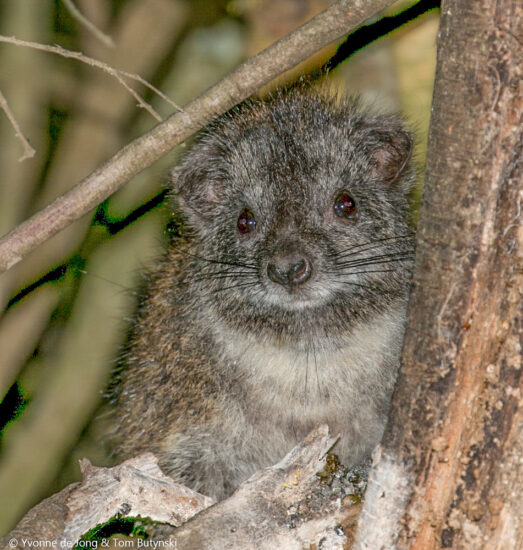
Western tree hyrax (Dendrohyrax)
The calls of tree hyraxes have been used to help define a newly recognised species (the Benin tree hyrax, Dendrohyrax interfluvialis) living in West Africa between the Niger and Volta rivers (Oates et al. 2021). We compared the calls of hyraxes from this region with those of the six most commonly recognised subspecies of western tree hyrax, Dendrohyrax dorsalis occurring across the Guineo-Congolian rain forest from Sierra Leone to Uganda. Whereas the calls of each subspecies had a consistent structure, the calls of the interfluvial population were strikingly different (listen below). We then compared details of skull morphology between populations, and analysed samples of mtDNA; these data confirmed the existence of two distinct species. Note that only one call type is known for each of these species (klaxon calls in D. dorsalis vs. rattles and barks in D. interfluvialis – see below) and the pattern of calling follows a species-typical pattern each time the call is made.

Benin tree hyrax Dendrohyrax interfluvialis at Nyagbo Anyigbe, Volta Region of eastern Ghana. Cameratrap image by E. Wiafe and J. Oates.
| D. d. sylvestris | Ankasa, Ghana. By Claude Chappuis | ||
| D. d. nigricans | Korup, Cameroon. By Christos Astaras | ||
| D. d. dorsalis | Gran Caldera, Bioko Island. By Tom Butynski | ||
| D. d. emini | Bili, N. DRC. By Tom Butynski | ||
| D. d. marmota | Mpanga, Uganda. By Lesley Ambrose | ||
| D. d. latrator | Lokutu DRC. By Tom Butynski | ||
| D. interfluvialis | Okomu, W. Nigeria. By Simon Bearder |

Captive Bioko western tree hyrax Dendrohyrax dorsalis dorsalis at Moka, Bioko, Equatorial Guinea. Photograph by J. Oates
Other species that are generally recognised within the genus Dendrohyrax are the southern tree hyrax, D. arboreus (±8 subspecies) and the eastern tree hyrax, D. validus (±4 subspecies – details of the distribution of subspecies can be found in Mammals of Africa, Volume 1). Across populations of southern tree hyraxes sampled to date there is a single characteristic call type, but with patterns of regional variation, as follows:
| D. arboreus | Type 1. Rattles grading into screams; Karen, Kenya. By Andrew Perkin | ||
| D. arboreus | Type 2. Knocks, rattles and scream-rattles; Tongabezi, Zambia. By Bob Stjernstedt | ||
| D. arboreus | Type 3. Rattles, knocks and screams; Newcastle, S. Africa. By Simon Bearder |

Southern tree hyrax Dendrohyrax arboreus at Solio Ranch, Laikipia, Kenya. Photograph by Y. de Jong and T. Butynski.
Call variation of at least three types is also found among sampled populations of eastern tree hyraxes in the Eastern Arc Mountains, but here the situation is more complex. In Type 1 there appears to be a single call that follows the same pattern each time it is given. In Type 2 some calls follow a characteristic pattern but others do not, and in Type 3 there are several different call types that can be given alone, but they are sometimes strung together in idiosyncratic combinations that can last for several minutes. These have been described as “songs,” akin to the songs of rock hyraxes (Ref. link to Rosti et al):
| D. validus | Type 1. Patterned hacks; Zanzibar and Pemba, Tanzania. By Andrew Perkin |
|
|
| D. validus | Type 2. Hacks and hack-sequence; Udzungwa and Uluguru mountains, Tanzania. By Andrew Perkin |
|
|
| D. validus | Type 3. Wheeze-thwacks, wheezes, hick-hack-hocks, and snorts; Taitas, Kenya (alarm call galago in background) and E. Usambaras. By Andrew Perkin |
|
Other species of hyrax in current taxonomies are the rock hyrax, Procavia capensis (>17 subspecies) and the bush hyrax, Heterohyrax brucei (>20 subspecies). These too exhibit regional variation in their patterns of calling but we do not yet have a sufficient range of recordings to make comparisons. It appears that, unlike tree hyraxes that call mostly at night, rock hyraxes call mostly during the day while bush hyraxes can be heard by day and by night (cathemeral).
| P. capensis | Song; Ein Gedi, Israel. By Lee Koren | ||
| H. brucei | Vibrating snorts; N. Scarp, Angola. By Simon Bearder |

Rock hyrax Procavia capensis at Lekurruki Conservancy, Laikipia, central Kenya. Photograph by Y. de Jong and T. Butynski.

Bush hyrax Heterohyrax brucei at Nasalot National Reserve, Kenya. Photograph by Y. de Jong and T. Butynski.
Click here to listen to additional recordings of the various hyrax taxa, additional photographs can be found on our Hyrax Photographic Map
Acknowledgements
Thanks go to all those who provided recordings. This page was produced in consultation with Tom Butynski, Yvonne de Jong, John Oates, Andrew Perkin, Diana Roberts, Hanna Rosti, Irena Schneiderova and Magdalena Svensson. Contact address Simon Bearder: skbearder@brookes.ac.uk

